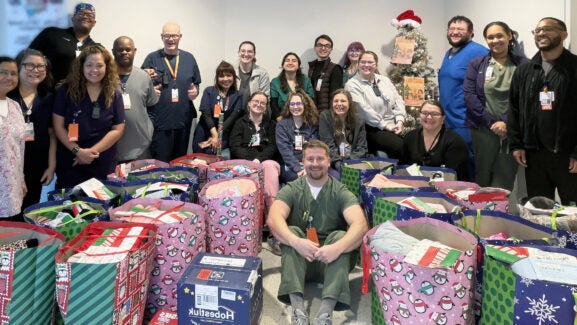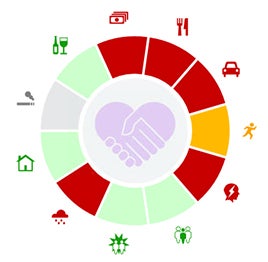

Jared McComb, Patient Advocacy Manager, works with the SDoH Rainbow Wheel
Wait. We’re Using a Rainbow Wheel, and It Can Help Patient Outcomes?
The Rainbow Wheel. It has a certain ring to it and sounds like fun. For the Population Health team, the newly available Epic application could be a game-changer. The wheel — which is officially known as the Social Determinants of Health (SDoH) Rainbow Wheel — is a tool that helps identify the socio-economic factors, health behaviors, and physical environments that may be impacting a patient’s overall well-being and creating barriers to healthcare.
Addressing SDoHs is important because they account for an estimated 80% of health outcomes in the United States. The remaining 20% are attributed to medical care (in a hospital or clinic).
“The recognition and management pathways between SDoH risks and health outcomes are complex and varied throughout UVA Health,” observes Novella Thompson, Population Health Administrator. “The tools to address those barriers haven’t always been readily available.”
The Rainbow Wheel application was part of the May 25 Epic upgrade, and its use is voluntary. At present, Population Health is managing a six-month pilot of the platform and rolling it out to clinics that have expressed interest in using it.
The Rainbow Wheel assessment process begins with having patients complete a SDoH survey. For now, surveys will only be sent to patients with MyChart accounts who are either enrolled in a Population Health program or receive care at one of the pilot clinics.
Responses are displayed on screen in a multi-colored Rainbow Wheel, enabling providers and care teams to visualize and begin to understand the risk levels of a patient’s current SDoH factors. (Note: The SDoH Rainbow Wheel and the accompanying patient survey do not contain Patient Health Questionnaire [PHQ] information.)
The Rainbow Wheel pilot is the first phase of a multi-step approach to addressing the SDoH needs of our patients. Phase two will begin later this year, when resources of the Unite Us/Unite Virginia network become available to UVA Health clinicians.
As Thompson explains, “This pilot represents a start in equalizing the ability of providers and care teams using Epic to both recognize and apply SDoH information to the benefit of the patients we serve.”
She adds, “People are going to want to use the Rainbow Wheel, and I welcome that. It’s important they know how to read it and that teams like Population Health are actively engaged and working with their patients to address the needs flagged.”
More information about the Rainbow Wheel and tip sheets are coming soon. Please email questions to populationhealth@virginia.edu or submit technical questions via an 2Epic ticket.
Latest News




